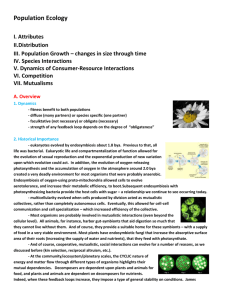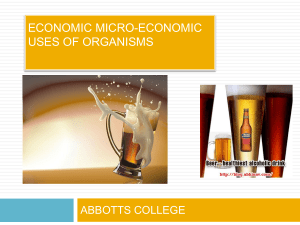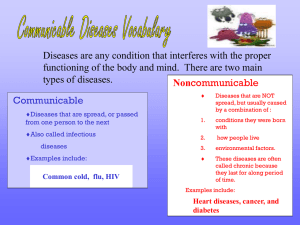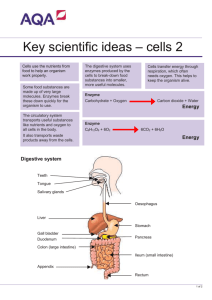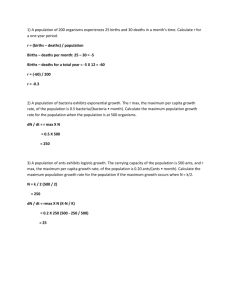Mutualisms II
advertisement
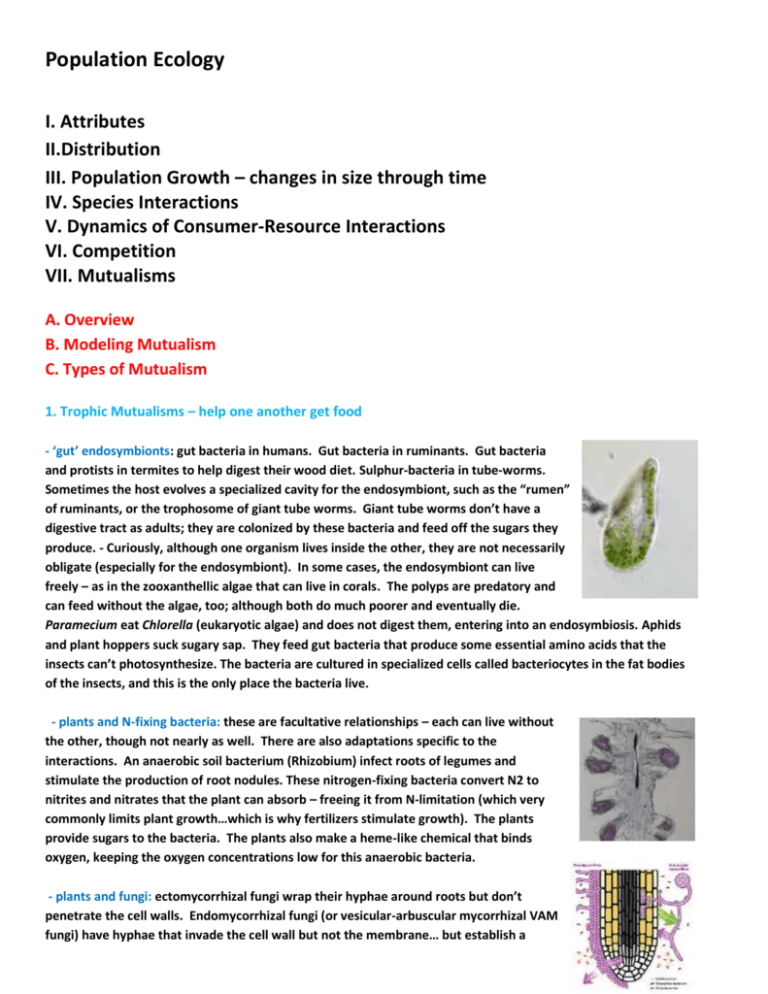
Population Ecology I. Attributes II.Distribution III. Population Growth – changes in size through time IV. Species Interactions V. Dynamics of Consumer-Resource Interactions VI. Competition VII. Mutualisms A. Overview B. Modeling Mutualism C. Types of Mutualism 1. Trophic Mutualisms – help one another get food - ‘gut’ endosymbionts: gut bacteria in humans. Gut bacteria in ruminants. Gut bacteria and protists in termites to help digest their wood diet. Sulphur-bacteria in tube-worms. Sometimes the host evolves a specialized cavity for the endosymbiont, such as the “rumen” of ruminants, or the trophosome of giant tube worms. Giant tube worms don’t have a digestive tract as adults; they are colonized by these bacteria and feed off the sugars they produce. - Curiously, although one organism lives inside the other, they are not necessarily obligate (especially for the endosymbiont). In some cases, the endosymbiont can live freely – as in the zooxanthellic algae that can live in corals. The polyps are predatory and can feed without the algae, too; although both do much poorer and eventually die. Paramecium eat Chlorella (eukaryotic algae) and does not digest them, entering into an endosymbiosis. Aphids and plant hoppers suck sugary sap. They feed gut bacteria that produce some essential amino acids that the insects can’t photosynthesize. The bacteria are cultured in specialized cells called bacteriocytes in the fat bodies of the insects, and this is the only place the bacteria live. - plants and N-fixing bacteria: these are facultative relationships – each can live without the other, though not nearly as well. There are also adaptations specific to the interactions. An anaerobic soil bacterium (Rhizobium) infect roots of legumes and stimulate the production of root nodules. These nitrogen-fixing bacteria convert N2 to nitrites and nitrates that the plant can absorb – freeing it from N-limitation (which very commonly limits plant growth…which is why fertilizers stimulate growth). The plants provide sugars to the bacteria. The plants also make a heme-like chemical that binds oxygen, keeping the oxygen concentrations low for this anaerobic bacteria. - plants and fungi: ectomycorrhizal fungi wrap their hyphae around roots but don’t penetrate the cell walls. Endomycorrhizal fungi (or vesicular-arbuscular mycorrhizal VAM fungi) have hyphae that invade the cell wall but not the membrane… but establish a more intimate relationship with the plant. Both types of fungi increase the absorptive power for water and nutrients, and they are fed photosynthate in return. Orchids have evolved obligate relationships with their fungi. The hyphae grow through the seed coat to help the seed germinate. Orchid can’t live without the fungus. - algae and fungi: lichens. Fungi are only associated with one algal species, but an algae can have different fungal partners. These are all obligate; the fungi gets sugar and the algae gets inorganic minerals. - mixed foraging flocks often occur when resources dwindle. Birds of several species will flock together, hunting for resources. These are very dynamic and labile interactions; the flock breaks up and can be composed of different individuals and species over time. Very diffuse and informal. 2. Defensive Mutualisms – trade protection for food - Animals and Food Sources: 1. Leaf-cutter ants and their fungal gardens: Leaf cutters cut leaves and return them to the nest where they chew them into a mulch. They grow a single species of fungus on the mulch, and this is the only place this fungus grows. The ants farm the fungus – it is all they eat. In addition, they ‘farm’ the fungus, weeding other fungi and pathogens. 2. Ant-Acacia Interactions: Several species of ants have coevolved with acacia trees, from facultative to obligate relationships. In the facultative relationships, ants visit for pollen and nectar, and provide some defense while they are there. In the obligate relationships, the ants nest in hollow thorns, they eat nectar, pollen, and specialized fatty structures produced by the plant called Beltian bodies. So, they get protein, fats, carbos, and a place to live. They are very aggressive, and attack if the plant is disturbed – just like disturbing an ant nest in the ground. One of the most interested recent reports shows the dependency of this relationship on the environment – specifically the abundance of large herbivores. In Africa, the decline in native herbivores in certain areas changes the fitness relationships…essentially, if herbivory is reduced, then “paying” the ants “protection money” is not worth it – and plants that don’t make thorns have higher fitness than those that do. 3. Ants and Aphids: Ants farm aphids like cows… they eat the ‘honeydew’ that aphids secrete, and they herd them around to new plants and protect them from predators and parasites. - Cleaning Mutualisms The cleaner gets a meal, and the individual that is cleaned gets ‘protected’ from its parasites. Tick birds and their large mammal hosts are a good example. Another interesting example is ‘cleaning stations’ in marine fish communities. Certain fish will clean parasites off others. The parasite laden fish will line up, waiting for service from the cleaners at their cleaning station! There are some very interesting social interactions here, akin to the “reputation” hypothesis of altruism. Cleaners remove parasites, but they can also take bites out of their hosts! Fish watch, and go to cleaners that ‘cheat’ less. In addition, there are mimic cleaners that are different species… and they just bite. 3. Dispersive Mutualisms: trade food for transport 1. Pollination: bees, wasps, ants, butterflies, moths, flies, birds, bats, and some other small mammals visit flowers, eat nectar and pollen, and disperse pollen. These interactions can be diffuse, specific, facultative, and obligate. Syndromes such as red = hummingbird, broad and white and open at night = bat, create some easy patterns and some general taxonomic specificity. 2. Seed Dispersal: Animals eat the seeds, digest the fruit, and the seeds pass through the gut or are regurgitated. Study Questions: 1) Describe four examples of ‘gut’ endosymbionts; two facultative and two obligate. 2) Why do some plants form mutualistic relationships with N-fixing bacteria, how do they do it, and what group of plants do it? 3) What are the two types of relationships between fungi and plant roots, and what are the benefits to each partner? 4) Describe the range of relationships between ants and acacias, and describe how the intimacy of these relationships may depend on the presence of large herbivores. 5) List three pollination syndromes. 6) Describe two ways that plants can attract specific pollinators. 7) How do cleaner fish and their “clients” balance the possibility of parasitism against the benefits of mutualism?
